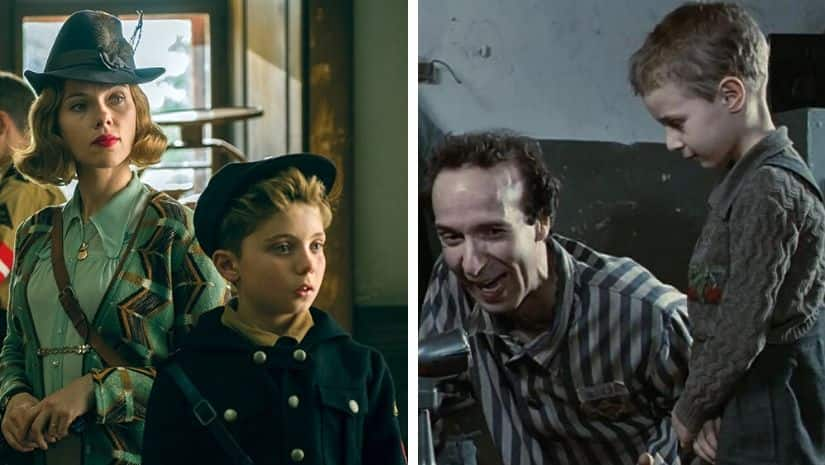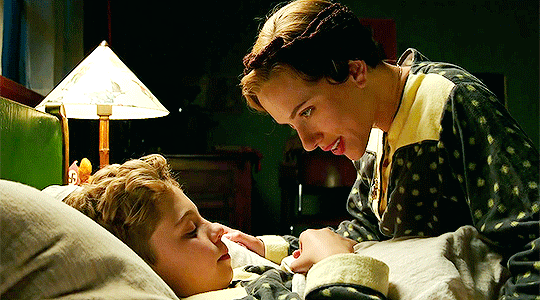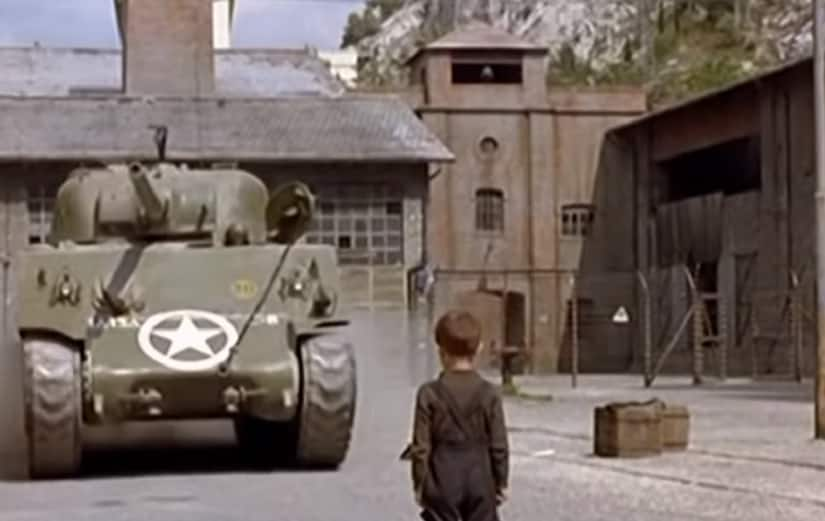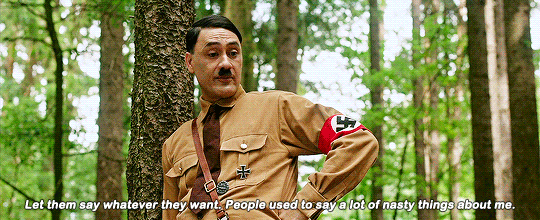A week ahead of the
92nd Academy Awards
, I watched Taika Waititi’s satire
Jojo Rabbit
in cinemas when it released on 31 January in India. The theatre had a special section for kids, with colourful seats, stuffed toys, and slides. It was a befitting environment to watch the multiple Oscar-nominated film particularly because the narrative unfurls through the lens of a child in Nazi Germany; a child who is indoctrinated to serve Adolf Hitler’s army, right from the young age. The subject and certain motifs took me back to yet another film that had a child as the focal point (though in only the second half) and Nazi Germany as the setting. Roberto Benigni’s 1997 Italian film Life Is Beautiful narrates the story of the persecution of Jews in Nazi Germany during World War II, though from the other side of the fence. The subject, Giosque, is a child of Italian Jew Guido, played by Benigni himself. Since he is a Jewish child in a Nazi concentration camp, his side of the story entailed the survival of Jews, as opposed to Jojo Rabbit, where the protagonist is being trained to eliminate Jews from Nazi Germany. [caption id=“attachment_8006601” align=“alignnone” width=“825”]
 Stills from Jojo Rabbit and Life Is Beautiful. Twitter[/caption] Here are the commonalities between both the films that are 22 years apart yet similar in many ways. The Holocaust is no child’s play When Life Is Beautiful premiered at Cannes Film Festival back in 1997, it was criticised for making light of the Holocaust. But it underlined the tragedy with tools like humour, imagination, and hope. It showed how a father conditioned his son to believe the Nazi concentration camp was a game, where a number of people were competing for the win. Horrors such as atrocities against Jews and separation from his mother were diminished to rules of the game, thanks to his father’s unwavering conquest to paint a rosy picture for his son.
Stills from Jojo Rabbit and Life Is Beautiful. Twitter[/caption] Here are the commonalities between both the films that are 22 years apart yet similar in many ways. The Holocaust is no child’s play When Life Is Beautiful premiered at Cannes Film Festival back in 1997, it was criticised for making light of the Holocaust. But it underlined the tragedy with tools like humour, imagination, and hope. It showed how a father conditioned his son to believe the Nazi concentration camp was a game, where a number of people were competing for the win. Horrors such as atrocities against Jews and separation from his mother were diminished to rules of the game, thanks to his father’s unwavering conquest to paint a rosy picture for his son.  Similarly, the tone of Jojo Rabbit, though satirical, treads the fine line of sensitivity through the perspective of the titular character, a child being trained to be a part of the German army. He is initially hesitant and is therefore compared to a scared rabbit. But as the film progresses, the use of a rabbit as a symbol presents itself in a new light. The ‘rabbit’ here refers to the rabbit hole of hate and revenge. Jojo grew up in a racially insensitive enviornment, but thanks to his Jewish friend Elsa (Thomas McKenzie), he comes out a changed man — or well, a boy. Moms and dads who love to dream and dance Benigni’s Guido leads his son Giosque to believe they are in the middle of a game, where Nazi soldiers are in costumes, and there are children of other Jew captors hiding in the vicinity. Giosque goes on to play the game even after the end of the war and the execution of his father. He reunites with his missing mother (since women and men had separate concentration camps) in the climax but a voiceover of the grown-up Giosque says his father made several sacrifices to protect him — and his story.
Similarly, the tone of Jojo Rabbit, though satirical, treads the fine line of sensitivity through the perspective of the titular character, a child being trained to be a part of the German army. He is initially hesitant and is therefore compared to a scared rabbit. But as the film progresses, the use of a rabbit as a symbol presents itself in a new light. The ‘rabbit’ here refers to the rabbit hole of hate and revenge. Jojo grew up in a racially insensitive enviornment, but thanks to his Jewish friend Elsa (Thomas McKenzie), he comes out a changed man — or well, a boy. Moms and dads who love to dream and dance Benigni’s Guido leads his son Giosque to believe they are in the middle of a game, where Nazi soldiers are in costumes, and there are children of other Jew captors hiding in the vicinity. Giosque goes on to play the game even after the end of the war and the execution of his father. He reunites with his missing mother (since women and men had separate concentration camps) in the climax but a voiceover of the grown-up Giosque says his father made several sacrifices to protect him — and his story.  In Jojo Rabbit, the familial influence is Scarlett Johansson’s Rosie, Jojo’s mother, who is both protective about her son yet encourages him to face the harsh realities of life. She encourages him to go out because it would help him recuperate from a face-deforming training ground injury. Since she is aware he is heavily indoctrinated (“he cried when he learnt his grandfather was not blonde”), she counters his parroted remarks about the othering of Jews with sermons on love, life, and dance (accompanied by a foot-tapping demonstration). She encourages him to take time out from his hatred-driven training sessions to cycle with her in the countryside. That lump in the throat The climactic scene of Life Is Beautiful is surely etched in the memory of every viewer. When the Allied Powers invade the Nazi concentration camp, Guido instructs Giosque to hide till the commotion gets over, and if he does, he gets to take a military tank home. The kid follows his father’s last words obediently, and pops out only when the war ends. Against a battered town with residues of World War II, he is seen celebrating his victory in the game. Astonishment spreads all over his face as he sees an advancing US military tank. With his father’s untimely demise looming large, the misguided (?) celebration of the child stands in stark contrast to the proceedings. [caption id=“attachment_8006581” align=“alignnone” width=“825”]
In Jojo Rabbit, the familial influence is Scarlett Johansson’s Rosie, Jojo’s mother, who is both protective about her son yet encourages him to face the harsh realities of life. She encourages him to go out because it would help him recuperate from a face-deforming training ground injury. Since she is aware he is heavily indoctrinated (“he cried when he learnt his grandfather was not blonde”), she counters his parroted remarks about the othering of Jews with sermons on love, life, and dance (accompanied by a foot-tapping demonstration). She encourages him to take time out from his hatred-driven training sessions to cycle with her in the countryside. That lump in the throat The climactic scene of Life Is Beautiful is surely etched in the memory of every viewer. When the Allied Powers invade the Nazi concentration camp, Guido instructs Giosque to hide till the commotion gets over, and if he does, he gets to take a military tank home. The kid follows his father’s last words obediently, and pops out only when the war ends. Against a battered town with residues of World War II, he is seen celebrating his victory in the game. Astonishment spreads all over his face as he sees an advancing US military tank. With his father’s untimely demise looming large, the misguided (?) celebration of the child stands in stark contrast to the proceedings. [caption id=“attachment_8006581” align=“alignnone” width=“825”]
 A still from Life Is Beautiful. YouTube[/caption] Jojo Rabbit also ends with a similar invasion by the Allied Powers on the Nazi colony but the ’lump-in-the-throat moment’ arrives a couple of scenes earlier. *Spoiler alert* A special mention must be given to the recurrent visual of Rosie’s shoes, a symbolic representation of ‘dance till you die.’ The pair of shoes is in the close-up in three key shots across the narrative. The first, when she is waiting for Jojo to finish his swimming exercise. The second, moments before she urges Jojo to dance. And third, the most telling one, when she is hanging in the centre of the courtyard. A butterfly leads Jojo to his mother’s hanging body. The focus is on only the shoes as the camera does not dare to tilt above to her face. As Jojo hugs his mother’s legs, he is reminded of what she told him about what those who were hung in the courtyard did (to deserve this): “What they could.” *Spoiler alert ends* Imagination as a weapon of choice A child’s fertile imagination has been used creatively by both the filmmakers. In Life is Beautiful, Benigni is subjected to the gruesome realities of war and being born in an ostracised race. However, that never stops him from painting an entirely different picture for his son. He does not want Giosque’s initiation into the world to be marred by sociopolitical realities and an overarching feeling of fear. By making him believe the Nazi concentration camp is in fact a game, he lets sunshine permeate into the dingy chambers they are confined to.
A still from Life Is Beautiful. YouTube[/caption] Jojo Rabbit also ends with a similar invasion by the Allied Powers on the Nazi colony but the ’lump-in-the-throat moment’ arrives a couple of scenes earlier. *Spoiler alert* A special mention must be given to the recurrent visual of Rosie’s shoes, a symbolic representation of ‘dance till you die.’ The pair of shoes is in the close-up in three key shots across the narrative. The first, when she is waiting for Jojo to finish his swimming exercise. The second, moments before she urges Jojo to dance. And third, the most telling one, when she is hanging in the centre of the courtyard. A butterfly leads Jojo to his mother’s hanging body. The focus is on only the shoes as the camera does not dare to tilt above to her face. As Jojo hugs his mother’s legs, he is reminded of what she told him about what those who were hung in the courtyard did (to deserve this): “What they could.” *Spoiler alert ends* Imagination as a weapon of choice A child’s fertile imagination has been used creatively by both the filmmakers. In Life is Beautiful, Benigni is subjected to the gruesome realities of war and being born in an ostracised race. However, that never stops him from painting an entirely different picture for his son. He does not want Giosque’s initiation into the world to be marred by sociopolitical realities and an overarching feeling of fear. By making him believe the Nazi concentration camp is in fact a game, he lets sunshine permeate into the dingy chambers they are confined to.  As opposed to the ever-so-reliable tool of escapism in Life Is Beautiful, Jojo Rabbit portrays imagination in a completely different light. A recurrent character is that of his imaginary friend Adolf Hitler, played by Waititi himself. Hitler here is more a friend to Jojo as opposed to the dictator we know. Jojo also shares a beautiful bond with the Jewish girl Elsa. The closing moments of the film shows Jojo and Elsa dancing, symbolising the inherent rhythm of life. Music makes the heart go deeper Nicola Piovani won the Best Music award at the Oscars in 1998 for his immensely uplifting original compositions in Life Is Beautiful. The music shines through, right from the first half that sees the blossoming romance between Giosque’s parents, to the second half, where the sunshine dips yet the undercurrent remains persistently optimistic. Even the tragic end cannot make the viewer completely pessimistic only because the music underlines the fact that sunny days are right around the corner and that joy can coexist in the darkest of times.
As opposed to the ever-so-reliable tool of escapism in Life Is Beautiful, Jojo Rabbit portrays imagination in a completely different light. A recurrent character is that of his imaginary friend Adolf Hitler, played by Waititi himself. Hitler here is more a friend to Jojo as opposed to the dictator we know. Jojo also shares a beautiful bond with the Jewish girl Elsa. The closing moments of the film shows Jojo and Elsa dancing, symbolising the inherent rhythm of life. Music makes the heart go deeper Nicola Piovani won the Best Music award at the Oscars in 1998 for his immensely uplifting original compositions in Life Is Beautiful. The music shines through, right from the first half that sees the blossoming romance between Giosque’s parents, to the second half, where the sunshine dips yet the undercurrent remains persistently optimistic. Even the tragic end cannot make the viewer completely pessimistic only because the music underlines the fact that sunny days are right around the corner and that joy can coexist in the darkest of times.  Michael Giachchino sets the musical tone of Jojo Rabbit in similar fashion. It is not as zany as Waititi’s screenplay but rather adds to the big heart that pounds throughout the film. The music is as much a character in the film as the mother who loves to dance. Life Is Beautiful won the Best Foreign Film, Best Actor, and Best Music awards at the Oscars in 1998. Given the similar plot and treatment, and a better structure that Jojo Rabbit boasts of, its chances at the 92nd Academy Awards are not too bleak either.
Michael Giachchino sets the musical tone of Jojo Rabbit in similar fashion. It is not as zany as Waititi’s screenplay but rather adds to the big heart that pounds throughout the film. The music is as much a character in the film as the mother who loves to dance. Life Is Beautiful won the Best Foreign Film, Best Actor, and Best Music awards at the Oscars in 1998. Given the similar plot and treatment, and a better structure that Jojo Rabbit boasts of, its chances at the 92nd Academy Awards are not too bleak either.
Twitter handle - @inkedinwhite
)